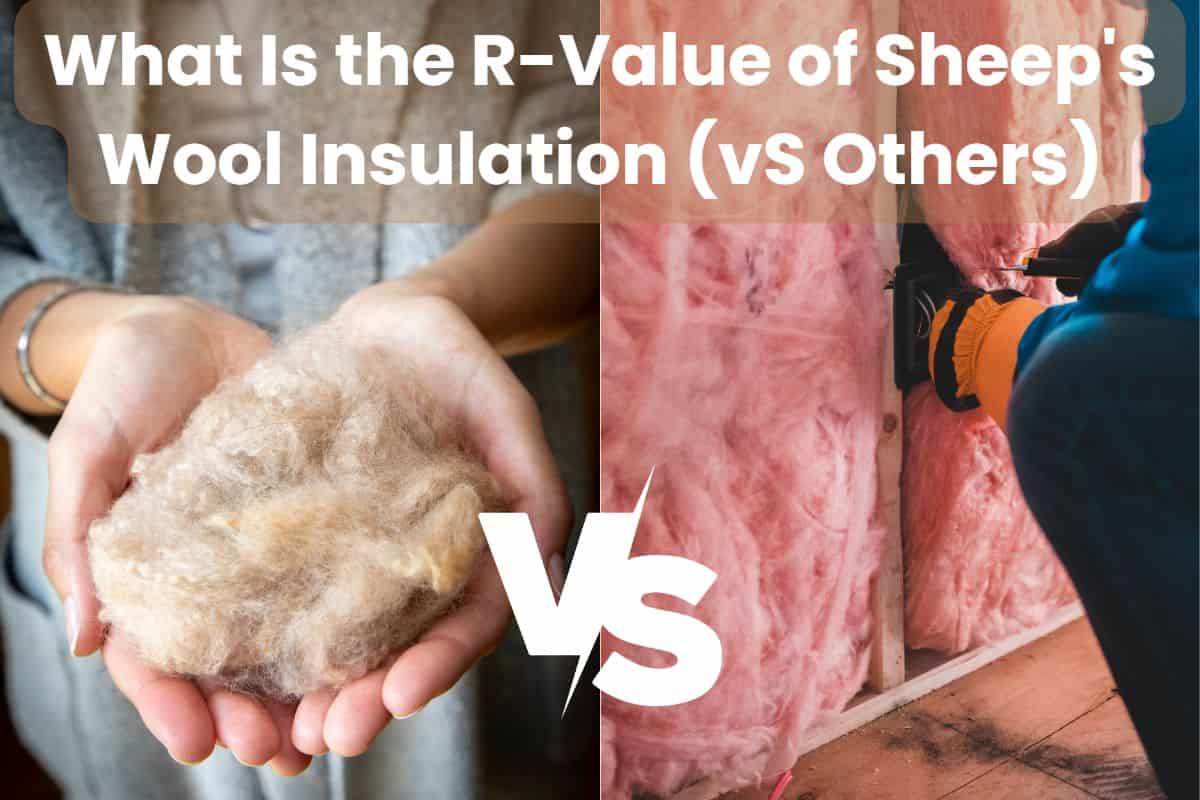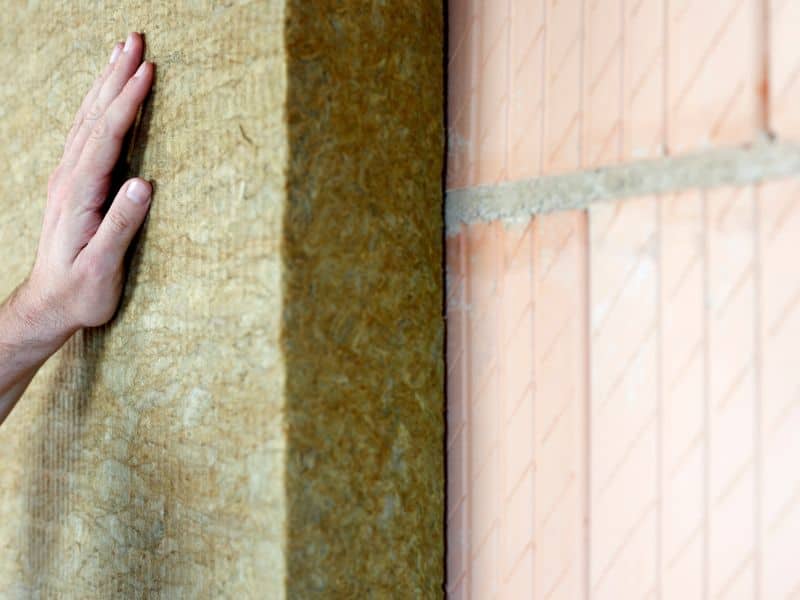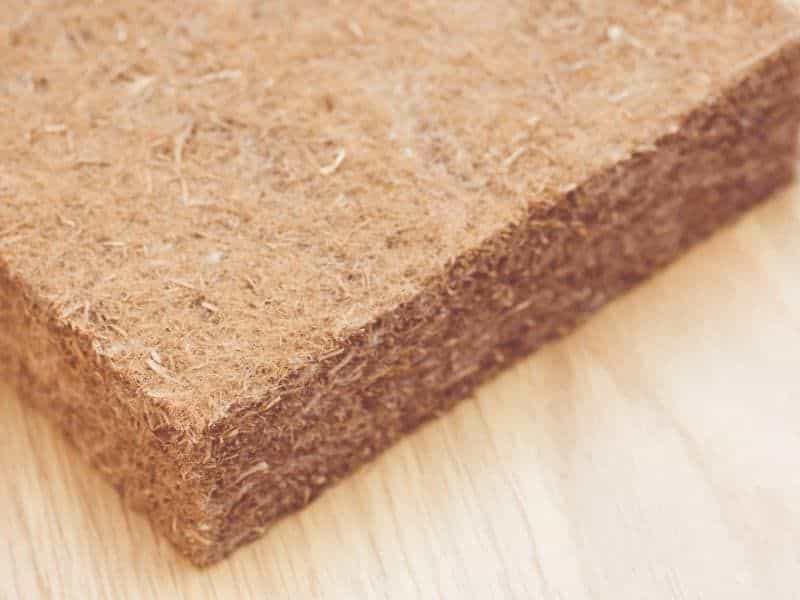What Is the R-Value of Sheep’s Wool Insulation (vS Others)

R-value is an essential factor to consider when looking for insulation material. An insulation material’s R-value refers to its ability to resist heat flow – the higher the value, the better the insulation material.
With that in mind, and before narrowing down your choice of insulation to sheep’s wool insulation, you should know the answer to the question, “What is the R-value of sheep’s wool insulation?”
The R-value of sheep’s wool insulation is R-3.6 per inch for loose-fill and blown-in options and R-4.3 for batts. This is a higher R-value than that of cellulose, fiberglass, and mineral wool by 0.3 to 0.6 points. Therefore, sheep’s wool insulation is better than these options.
In the rest of this article, I’ll compare sheep’s wool insulation to other options using various criteria, including their R-values.
I’ll also discuss why sheep’s wool is a good insulator and what its thickness should be for the best outcome. Let’s get started!
Sheep’s Wool and Other Types of Insulation
Besides sheep’s wool insulation, you might want to consider other types of insulation. Let’s briefly review these types of insulation to understand how they compare to sheep’s wool.
Cellulose

This is sustainable insulation made with up to 85% recycled newspaper. It may also contain denim.
Small pieces of ground-up recycled paper are fiberized in its production, making them denser to prevent airflow.
The insulation is treated with non-hazardous chemicals like borax, boric acid, or ammonium sulfate to make it fire-resistant.
There are two main types of cellulose insulation:
- Dense-packed: Best for walls and ceilings.
- Loose-fill: Best for attics.
Fiberglass Insulation

This is an insulation made of plastic reinforced with tiny glass fibers.
Fiberglass batt, a form of fiberglass insulation, is so common that it accounts for 52 percent of insulation applications in new single-family homes.
Fiberglass insulation is made by spinning molten glass fibers while coating them with a liquid binder to form the batts. The blown-in fiberglass insulation doesn’t incorporate the binder.
The two main forms of fiberglass insulation are:
- Batt insulation: It’s best for walls and ceilings.
- Blown-in: Best for uneven areas like around pipes, wire, and attics.
Spray Foam Insulation

Spray foam, or spray polyurethane foam (SPF), is a liquid foam that forms into an insulating layer when sprayed into position. It’s best for roofs, lofts, walls, and ceiling cavities.
Spray foam insulation is the best option for air sealing. This is especially beneficial if your furnace and air conditioner run constantly.
The two types of spray foam insulation include:
- Closed cell: It sets into a rigid and solid layer. Therefore, it provides structural support. However, you shouldn’t use it as a quick structural fix.
- Open cell: This less-dense option doesn’t form a thick layer. It’s best for sound insulation due to its high resistance to airflow.
Rockwool Insulation

Rockwool (stone wool) insulation is made by heating rock to its melting point, usually 1,600℃ (2,912℉), and then spinning it until it solidifies into fine threads.
The resulting material is used for insulation because:
- It’s a poor conductor of heat.
- It’s a sound dampener.
- It’s fire-resistant.
Rockwool is ideal for all insulations in a building.
Hemp Insulation

As the name suggests, this insulation is manufactured from hemp wool.
Hemp wool is exceptionally sturdy and durable, making it a suitable insulation material.
Hemp insulation is a composite material made up of up to 92% hemp fibers and 8% polyester fibers. Therefore, it’s considered eco-friendly.
This insulation comes in two forms:
- Insulation batts: These are pre-cut, standard sizes for walls, floors, and ceilings.
- Insulation boards: These are rigid boards for reducing sound transfer, including between floors and walls.
Cork Insulation

This is a sustainable and eco-friendly insulation made from the bark of cork oak trees.
The corks are steam-heated to expand and form active suberin, a waxy, organic substance resistant to fire and pests.
Cork insulation is lighter than other materials, making it easier to install. It’s available in three forms:
- Cork panels or boards: Are made by pressing the suberin into the desired shape, size, and thickness.
- Cork insulation rolls: These are cork sheets made into rolls. They are thinner, with depths of less than 5mm (0.20 inches). Thus, they are ideal for smaller spaces.
- Sprayed cork insulation: This is a mix of cork granules and resin that’s sprayed onto walls or ceilings.
R-Value of Sheep’s Wool Insulation VS Other Insulation Types
The table below compares sheep’s wool insulation with these other types in terms of their R-values and thermal conductivity.
| Insulation | R-Value Per Inch | Thermal Conductivity (W/mK) |
| Sheep’s wool | 3.6 to 4.3 | 0.035 to 0.04 |
| Cellulose | 3.2 to 3.8 | 0.040 |
| Batt fiberglass | Up to 4.3 | 0.04 |
| Blown-in fiberglass | 2.2 to 2.7 | 0.023 to0.04 |
| Open cell spray foam | 3.5 | ≤ 0.036 |
| Closed cell spray foam | 7.0 | 0.02 and 0.03 |
| Rockwool | 3.0 to 3.3 | 0.047 |
| Hemp | 3.5 | 0.039 |
| Cork | 3.6 to 4.2 | 0.036-0.38 |
How Thick Should Sheep’s Wool Insulation Be?
The thickness of sheep’s wool insulation depends on the specific application, as discussed below:
- Attics: At least 120mm (4.72 inches) thick for existing attics and 240mm (9.45 inches) for new houses.
- External walls: 140mm (5.51 inches) thick for timber-framed houses.
- Internal walls: 80 to 100mm (3.15 to 3.94 inches) thick between stud partitions.
- Flooring: More than 100mm (3.94 inches) thick between floors.
- Roofing: 200mm (7.87 inches) for roofline installations.
Is Sheep’s Wool a Good Insulator?

Sheep’s wool is a good insulator for the following reasons:
- Low thermal conductivity: Individual wool fibers have hollow spaces (medulla). These spaces decrease thermal conductivity, enhancing the wool’s insulation capacity.
- High R-value: The higher the R-value, the better the material’s insulation. Sheep’s wool has an impressive R-value between 3.6 and 4.3 per inch, making it an excellent insulator.
- Natural crimp: Wool fibers are naturally crimpy (springy). This feature gives them a natural loft, increasing their ability to trap air. Trapped air is a poor conductor of heat.
- Fire-resistance: Sheep’s wool is naturally fire-resistant due to its high ignition temperature. It slows down the spread of a flame, making it an ideal choice for fire safety.
- Noise reduction: Wool fibers are excellent at sound-dampening. They can absorb up to 55% of noise. This makes sheep’s wool insulation suitable in areas with lots of noise.
- Chemical-free: Sheep’s wool is free from chemicals and toxins. Therefore, it’s non-toxic and safe for installation in homes.
- Excellent hygroscopic qualities: Sheep’s wool is an excellent hygroscopic material that can absorb up to 33% of its weight in moisture. Even when it absorbs such an amount of moisture, the wool doesn’t compromise its thermal efficiency. It stores the moisture in its fibers and releases it when heated. This ensures that a building’s energy efficiency remains high no matter the humidity.
- It suppresses mold and mildew: Sheep’s wool fibers contain natural keratin. This substance makes it difficult for mold and mildew to survive on the material’s surface.
- Long-lasting: Sheep’s wool insulation can last approximately 60 years. This makes it ideal for long-term investments.
Final Thoughts
Compared to conventional insulators, sheep’s wool insulation has a higher R-value, enhancing its thermal resistivity.
Besides insulation, it provides excellent sound dampening and fire resistance. It’s also chemical-free, making it an ideal choice for an eco-friendly home.
Ultimately, sheep’s wool insulation is ideal if you’re looking for a sustainable option with an impressive R-value. Its longer lifespan also makes it a worthwhile investment.
Check out this article for the key facts about sheep’s wool insulation and water damage.







